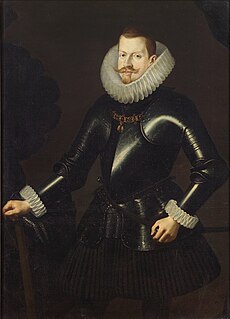 W
WJuan Del Águila y Arellano was a Spanish general. He commanded the Spanish expeditionary Tercio troops in Sicily then in Brittany, before serving as general of the Spanish armies in the invasion of Ireland (1600–1602). As a soldier, and subsequently Field Master of the Tercios, he was posted to Sicily, Africa, Malta, Corsica, Milan, the Netherlands, Spain, Portugal, France and Ireland, where he participated in major military events of his time, such as the Siege of Malta, the Looting of Antwerp, the Siege of Antwerp, the "Miracle of Empel", an expedition in support of the French Catholics, the Raid on Mount's Bay and another one in support of Irish rebels.
 W
WAntónio, Prior of Crato, was a grandson of King Manuel I of Portugal who claimed the Portuguese throne during the 1580 dynastic crisis. According to some historians, he was king of Portugal for 33 days in 1580. Philip II of Spain prevailed in the succession struggle, but António claimed the throne until 1583. He was a disciple of Bartholomew of Braga.
 W
WÁlvaro de Bazán, 1st Marquess of Santa Cruz, GE, KOS, was a Spanish admiral. He was never defeated, a remarkable achievement in a fifty-year long career. His personal galley, La Loba, thus called by her golden figurehead, was feared by Spanish enemies and regarded with hope amongst Spanish sailors and allies.
 W
WLuis Fajardo y Ruíz de Avendaño, KOC, known simply as Luis Fajardo, was a Spanish admiral and nobleman who had an outstanding naval career in the Spanish Navy. He is considered one of the most reputable Spanish militaries of the last years of the reign of Philip II and the reign of Philip III. He held important positions in the navy and carried out several military operations in which he had to fight against English, Dutch, French and Barbary in the Atlantic, the Caribbean and the Mediterranean. It is known for the conquest of La Mamora in 1614.
 W
WAlexander Farnese was an Italian noble and condottiero and later a general of the Spanish army, who was Duke of Parma, Piacenza and Castro from 1586 to 1592, as well as Governor of the Spanish Netherlands from 1578 to 1592. Thanks to a steady influx of troops from Spain, during 1581–1587 Farnese captured more than thirty towns in the south and returned them to the control of Catholic Spain. During the French Wars of Religion he relieved Paris for the Catholics. His talents as a field commander, strategist and organizer earned him the regard of his contemporaries and military historians as the first captain of his age.
 W
WJames VI and I was King of Scotland as James VI from 24 July 1567 and King of England and Ireland as James I from the union of the Scottish and English crowns on 24 March 1603 until his death in 1625. The kingdoms of Scotland and England were individual sovereign states, with their own parliaments, judiciaries, and laws, though both were ruled by James in personal union.
 W
WAlonso Pérez de Guzmán y de Zúñiga-Sotomayor, 7th Duke of Medina Sidonia, GE, was a Spanish aristocrat who was most noted for his role as commander of the Spanish Armada that was to attack the south of England in 1588.
 W
WCristóbal de Mondragón y Mercado (1514–1596) was a Spanish general during the Eighty Years' War.
 W
WAntonio de Oquendo y Zandategui was a Spanish admiral; in 1639 he was in command of the Spanish forces at the Battle of the Downs.
 W
WMiguel de Oquendo y Segura, was a Spanish Admiral. Born in San Sebastián (Gipuzkoa) in 1534, died at sea in 1588 when returning from the Spanish Armada campaign.
 W
WPhilip II also known as "Philip the Prudent" was King of Spain (1556–1598), King of Portugal, King of Naples and Sicily, and jure uxoris King of England and Ireland. He was also Duke of Milan from 1540. From 1555 he was Lord of the Seventeen Provinces of the Netherlands.
 W
WPhilip III was King of Spain. He was also, as Philip II, King of Portugal, Naples, Sicily and Sardinia and Duke of Milan from 1598 until his death in 1621.
 W
WAdmiral Juan Martínez de Recalde, KOS was a Spanish Navy officer who was named admiral of the fleet and second-in-command of the Spanish Armada, and commanded the San Juan de Portugal. He was a knight of the Order of Santiago.